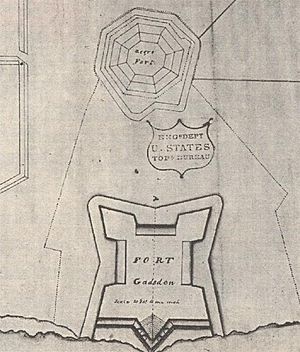| Battle of Negro Fort | |||||||
|---|---|---|---|---|---|---|---|
| Part of the Seminole Wars | |||||||
 Map of Fort Gadsden, inside the breastwork that surrounded the original Negro Fort. | |||||||
| |||||||
| Belligerents | |||||||
|
Creek |
Fugitive slaves Choctaw | ||||||
| Commanders and leaders | |||||||
|
| Garçon † | ||||||
| Strength | |||||||
|
267 2 gunboats | 334 | ||||||
| Casualties and losses | |||||||
|
3 killed 1 captured | 334 killed, wounded and captured | ||||||
| The fugitive slave and Choctaw casualties include women and children. | |||||||
Location within Florida | |||||||
Negro Fort was a short-lived fortification built by the British in 1814, during the War of 1812, in a remote part of what was at the time Spanish Florida. It was intended to support a never-realized British attack on the U.S. via its southwest border,[1] by means of which they could "free all these Southern Countries [states] from the Yoke of the Americans".[2]
Built on a site overlooking the Apalachicola River, about 15 miles north of present-day Apalachicola, Florida, it was the largest structure between St. Augustine and Pensacola.[3] Trading posts of Panton, Leslie and Company and then John Forbes and Company, loyalists hostile to the United States, had existed since the late eighteenth century there and at the San Marcos fort, serving local Native Americans and fugitive slaves. The latter, runaway or freed black slaves from plantations in the American South, used their experience of farming and animal husbandry to set up farms stretching for miles along the river.
When withdrawing in 1815, at the end of the war, the British commander Edward Nicolls, ensured that "the fort was left intact for the use of the Indians. Instead, it came into the possession of a band of free renegade Negroes."[4] It is the largest and best-known instance before the American Civil War in which armed fugitive Africans (they were no longer enslaved) resisted European Americans who sought to return them to slavery. (A much smaller example was Fort Mose, near St. Augustine.)
The fort was destroyed in 1816 when a "hot cannon ball"[5] landed in the magazine, destroying the fort. This action is also sometimes referred to as the Battle of Negro Fort (also called the Battle of Prospect Bluff or the Battle of African Fort). Colonel Duncan L. Clinch, the attacking commander, reported salvaging approximately "2,500 muskets, 50 carbines, [and] 400 pistols"[5] from the ruins; as well as inflicting nearly 300 casualties to the fort's occupants. The salvaged arms were given to Colonel Clinch's allies, the Creeks, as war booty for their help in taking the fort.[5]
This is the only time in its history in which the United States destroyed a community of escaped formerly enslaved Black Americans in another country.[6] However, the area continued to attract escaped Africans until the U.S. construction of Fort Gadsden in 1818.
The Battle of Negro Fort was the first battle of the Seminole Wars.
- ^ Clavin, Matthew J. (2021). The Battle of Negro Fort : the rise and fall of a fugitive slave community. New York. p. 22. ISBN 9781479811106.
{{cite book}}: CS1 maint: location missing publisher (link) - ^ Clavin, 2021, p. 40
- ^ Clavin, 2021, p. 47
- ^ Mahon, John K. (1967) p. 22. History of the Second Seminole War 1835-1842 (Revised Edition), University of Florida Press.
- ^ a b c Mahon p. 23
- ^ Clavin, 2021, p. 14
© MMXXIII Rich X Search. We shall prevail. All rights reserved. Rich X Search

